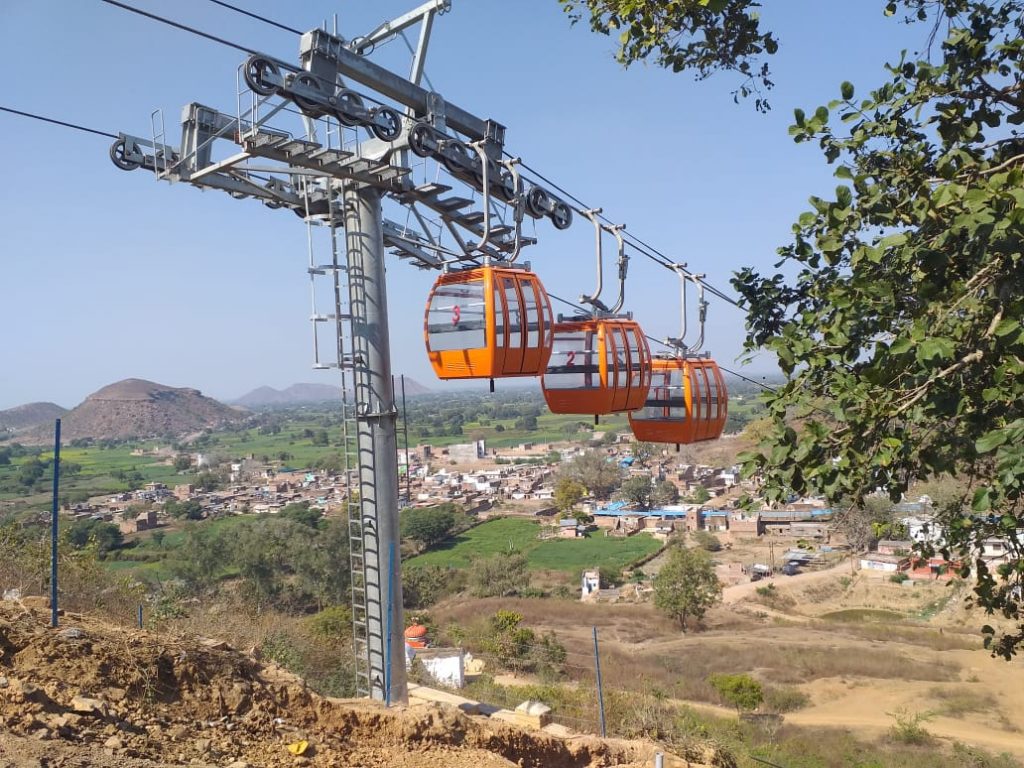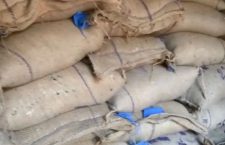An examination of sanctioned budgets for the chosen faithful, U.P, style, with a visit to the local dharmik site Lakshman Pahadi, where shiny cable cars are the new attraction
Lakshman Pahadi in Chitrakoot is a small hillock that is a major pit stop for religious tourists across the Hindi belt, as it is alleged to be Lakshman’s final place of rest. Lakhs of worshippers make the 156-step climb up the hill every year, which roughly takes 25-30 minutes and leaves most panting and breathless, clutching cramped legs and feet. As Pushpa, who’s come all the way from Kanpur, shares, “It was a very difficult climb. I’m completely out of breath and my heart rate is so high – and this is despite all the breaks we took.” She goes on to share that this is her second time visiting Lakshman Pahari, “The first time I did my darshan from below, at the foot of the hill.”
What prompted Pushpa to visit this time – besides good old faith – is the newly-completed, additional attraction at the site, which makes the climb easier. “I was just looking at the cable cars to see if they’re working,” she says, “If they were, I’d definitely be taking them.”
Pushpa is referring to the recently completed ropeway that had been constructed at the Mukhya Parikrama Marg and Lakshman Pahadi under the Swadesh Darshan Yojana (SDY). Launched in 2015 by the Ministry of Tourism to promote domestic tourism, the scheme has sanctioned planned tours divided into 15 categories. Chitrakoot is a destination of what is being popularly called, even amongst government officials, as the Ramayana Circuit, one of the many religion-centred circuits planned and created under the scheme.
In Uttar Pradesh, with Yogi Adityanath at the helm of the affairs, religious tourism has acquired distinctly Hindutva tones. Having conducted a ‘million-deep Bhavya Deepavali’ at Ayodhya barely a few months after he took office, the Chief Minister has been vocal in his support of religious tourism, aligning policies and budgets to it. The recently-concluded Kumbh mela, with a budget upwards of Rs. 4200 crores, is a strong example of this, especially in a state where the state of healthcare and other basic amenities, remains dismal.
The state aligns with the centre here. In 2018, when the federal Minister of State for Tourism, K.J. Alphons, said that the Indian government plans to promote religious tourism, citing allegedly statistics that claim that nearly 60% of all domestic tourism is religious tourism – a fact backed up with studies – the focal points of the designed ‘spiritual’ circuits are primarily temples and other institutes that have significance in Hinduism. There is a stray monastery or gurudwara in the plan, but dargahs and mosques are all but missing. This seems to be in line with the Hindu nationalist ideology of the current government, which has been renaming cities with Farsi names, enforcing draconian cow protection laws and saffronizing education.
The ropeway on Lakshman Pahadi was constructed in a public-private partnership (PPP) for Rs. 15 crores. It was one of the 74 projects costing Rs. 5987 crores sanctioned by the SDY. A significant portion of these projects works on improving infrastructure and access to places of spiritual or religious significance. Shakti Sinha Tomar, local MLA, representing popular BJP neta RK Singh Patel, clarifies, “Chitrakoot has great importance in religion. We see lakhs and crores of worshippers every month.” Tomar is all praise for the government, linking religious tourism to overall development, “The government has invested a lot of money in state tourism, a lot of funds have been released by the government to improve all the important spiritual sites in the district. See, they want to put Chitrakoot on the map as the premier location for worshippers. Only then can Chitrakoot develop.”
This is a powerful rhetoric, which resonates amongst local stakeholders such as small business owners. “Because of the ropeway, more tourists will come, so our businesses will flourish,” says Parmeshrar Dalal Shukla, a shopkeeper whose shop has been at Lakshman Pahadi for 30 years, “And in the Chitrakoot region, we have nothing like this, they’re all in Madhya Pradesh. But now that it is in Chitrakoot, tourists will come here too, and the village will develop and the shopkeepers will definitely benefit. This will benefit us hugely.”
Shukla’s comments, of course, are all predictions because of the ropeway is currently non-operational. “Because this was built by a public-private partnership, a private company has been selected through a consortium to take care of operations,” explains Vishakh G, the District Magistrate of Chitrakoot, “The safety audit is still pending; after it is completed, the ropeway will be operable.” He adds that the ropeway is merely one of the several upgradations being made to Lakshman Pahadi, “Through the Swadesh Darshan Yojana, Rs. 45 crores are being spent to improve tourists’ facilities – so there will be a food plaza, a foot-over bridge, covered sheds at Parikrama Bhag, Bhajan Sansthals.” The plans are big, as he describes them, “The irrigation and tourism departments have made public benches and undertaken renovations there. In the future, there will also be a sound and light show.”
“We’ll reach faster and it’ll be less troublesome,” says Pushpa, anticipating her next ride into Lakshman Pahadi seated in a cable car, “darshan achche se honge.” Rani, another visiting tourist however, believes in a different expression of faith. “We like to walk for our yatra,” she says, dismissing the cable cars altogether, “According to our religious beliefs, it’s better to walk this journey until you no longer have the strength in your body to do so.”
This Khabar Lahariya article first appeared on The Wire.


